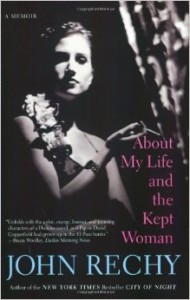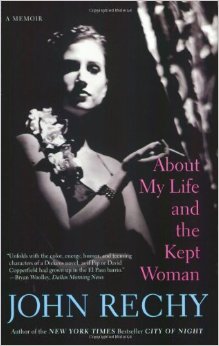 About My Life and the Kept Woman: A Memoir
About My Life and the Kept Woman: A Memoir
by John Rechy
Grove Press. 356 pages, $24.
THE AUTHOR of the groundbreaking novel City of Night (1963) and numerous other innovative novels, John Rechy became a writer when, in his mother’s bedroom in El Paso, while using a rented typewriter, he wrote a long letter to a stranger describing nights of “sex and liquor and pills and thieving” in New York, Los Angeles, and New Orleans. These nights were not the product of literary influences or a youthful writer’s imagination. They were the actual experiences of a young man who had earned a college degree, served in the Army, written an unpublished novel—and supported himself as a street hustler. Rechy did not mail the letter; instead, a few days later, on impulse, he revised it and sent it to the magazine Evergreen Review, which published it as “Mardi Gras,” a story described as part of a novel in progress.
Rechy never intended to write that novel. His experiences among the sexual outlaws of the early 1960’s caused him to be concerned that their lives, already marginalized, should not be exposed to the potential jeers of readers. More importantly, he knew that his ability to inhabit the cities of night depended on the preservation of his identity as a hustler. As Rechy has stated without apology throughout his career, he was drawn compulsively to what was for him the unique exhilaration of anonymous sexual encounters.
When his first published story attracted the attention of editors and other writers, Rechy hoped that this would result in a reading of Pablo!, a novel he wrote in college set in modern Mexico and based on Mayan myths. The manuscript of this never-published novel is mentioned a number of times in About My Life and the Kept Woman, Rechy’s memoir of his childhood in El Paso and his early years as a writer. He offers it to all the men who ever appeared interested in his writing only to reveal that what they really wanted was his body. These incidents go back to his adolescence, when various people—his high school journalism teacher, a college librarian, a strange married couple—attempted to seduce him after ostensibly taking an interest in his would-be writing career. Later on, even some famous writers took part in this courtship. Christopher Isherwood and Allen Ginsberg both tried unsuccessfully to get John Rechy to take off his clothes. Although Rechy never addresses the issue directly, readers of his work cannot avoid the conclusion that his sexy, muscular body and the writing that first made him famous are inextricably linked.
About My Life and the Kept Woman is divided into two parts. The first, which runs from his sister’s wedding in 1945 through Rechy’s discharge from the Army in the late 1950’s, contains the most personal writing he has ever published. Rechy grew up in the Mexican-American section of El Paso. He offers extended, loving portraits of his Mexican mother and his beautiful sister Olga. He acknowledges the shame he felt at being Mexican and the guilt at being able to pass as an Anglo. His Scottish father was a fearsome figure. An accomplished musician from a privileged family, he had to flee Mexico after the fall of Diaz. He had no skills that would enable him to support a family during the Depression; instead he spent his days tormenting his wife and children with sporadic threats of violence. He may have molested the young John. In taut prose, Rechy conveys the ugliness of poverty and the beautiful, harsh environment of the desert. This is the story of a bright, talented boy who grew increasingly handsome as he matured and knew a wider world awaited him. He caused a scandal when he attempted to make the college literary magazine a venue for serious avant-garde work. By chance he befriended a man stationed at a nearby Army base who had connections in the New York publishing world. This man fell in love with Johnny but did not attempt to take advantage of him. He was the person Rechy planned to ask for help in establishing himself as a writer when he returned from two years of military service in Germany.
Sexual situations crop up in the first part of the book, but the young Rechy seems uninterested in the men and women who pursue him. When he encounters overt homosexuality in the military, he dismisses it in prudish, almost homophobic terms. The second half of the book is quite different. In a comic turn of events, Rechy submits the manuscript of his novel to a writer’s workshop at Columbia University directed by Pearl Buck. Without receiving notice of his acceptance, he leaves for New York. When he discovers that Ms. Buck does not feel that she can help him in his writing, he finds himself alone and broke in the Sloane House YMCA. A man who sees him naked in the shower tells him about hustling at nearby Times Square, and John Rechy’s life suddenly changes. He joins the “dance of the streets.”
Rechy takes us into the world produced in City of Night and Numbers. People are anonymous, encounters are furtive, sexual roles are rigidly observed, and the police are a constant threat. Beyond economic necessity, Rechy offers little explanation for how a young writer became a young hustler. I believe this omission is intentional: Rechy has always maintained that his goal was to document the world of hustling and cruising without presuming to explain this world or its inhabitants. This is his strength as a writer and his point of vulnerability. Throughout his career, Rechy has run the risk of being dismissed as a writer of pornography. Much of his work is, like the photos of the author included in this book, sexually stimulating. Rechy compels his readers simply to look into a world of men whose lives are dominated by sex. He refuses to analyze or judge this world, which is why his novels are the most honest depiction we have of mid-20th-century sexual outlaws.
Rechy overcame his reservations about telling the stories of the hustlers and queens he encountered because he knew he had found his subject as a writer and realized that this was a way to lift himself and his family out of poverty. Forty-five years after the publication of City of Night, we can be grateful to have this memoir from its author, who is still handsome at 75. The kept woman in the title is the source of a mysterious childhood memory that recurs throughout the book and brings it to a moving conclusion.






